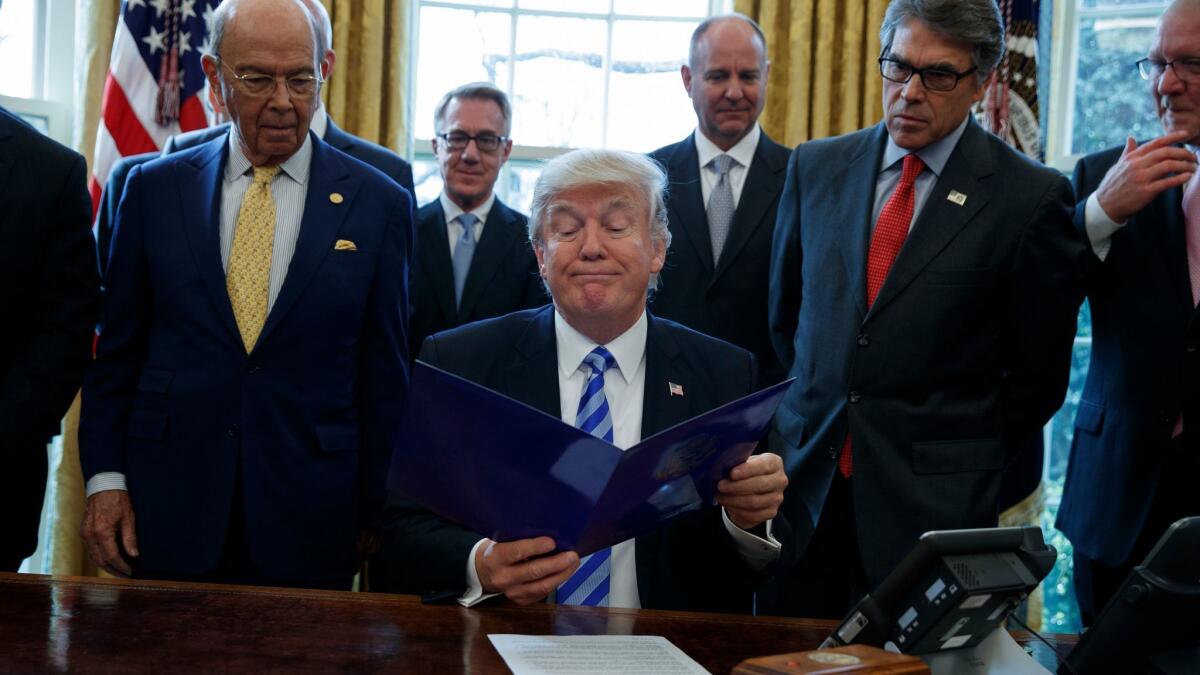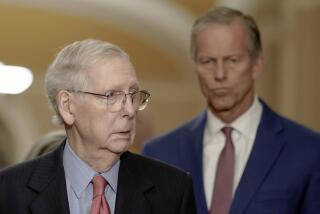Seeking a way forward, Trump increasingly finds himself at odds with his own party

President Trump won his office in spite of the best efforts of some in his party.
Now, the tenuous nature of the bonds between Trump and the GOP are increasingly on public display as the president openly feuds with conservatives and White House officials debate whether to reach out to Democrats in order to restart his domestic agenda.
The latest and strongest evidence came Thursday as Trump escalated his political battle against the members of the House Freedom Caucus, the conservative lawmakers who helped block the healthcare bill he backed.
Early in the morning, he said on Twitter that the caucus would “hurt the entire Republican agenda if they don’t get on the team.”
“We must fight them, & Dems, in 2018!” he added.
In the afternoon he singled out three of the group’s leaders by name, urging them to “get on board.”
It was an extraordinary message, suggesting that Trump might try to back challengers in primaries against lawmakers of his own party — something few presidents have tried, none with much success.
The problem Trump faces is the coalition that narrowly elected him crossed traditional party lines. It included Republicans, but also independent voters and some Democrats who had supported President Obama in both of his elections.
Most members of Congress were elected by more traditional partisans. That leaves Trump without a clear base in Congress that can be counted on to agree with him on his agenda, putting him almost in the position of a political independent.
Trump might have seemed to align most naturally – temperamentally, at least — with the Freedom Caucus. Both he and the caucus’ members have reveled in their ability to disrupt the party establishment. Some of the group’s leaders, including Chairman Mark Meadows (R-N.C.), were among his earliest supporters. But he blames them for last week’s collapse of the healthcare bill, even though many centrist Republicans opposed it, too.
In response to Trump’s attack, members of the group responded with a mix of disbelief and defiance. Few, if any, gave signs of being intimidated.
“It didn’t take long for the swamp to drain @realDonaldTrump,” responded Rep. Justin Amash (R-Mich.) on Twitter.
“Almost everyone succumbs to the D.C. Establishment.”
The White House said again Thursday that the president was now open to working with Democrats to advance remaining priorities.
“He has a bold and robust agenda that he is trying to enact, that he ran on and told the American people that he would do when he was president. And he’s going to get the votes from wherever he can,” Press Secretary Sean Spicer said.
House Speaker Paul D. Ryan (R-Wis.) told reporters Thursday that he shared Trump’s frustration with the Freedom Caucus, a group that has stymied House leadership before – especially under his predecessor, John A. Boehner.
But in an interview with CBS News, Ryan expressed concern about Trump’s new interest in bipartisanship, at least on healthcare.
“What I worry about … is that if we don’t do this, then he’ll just go work with Democrats to try and change Obamacare, and that’s not – that’s hardly a conservative thing,” Ryan said.
Fissures in the Republican coalition long predate Trump’s election. But what is especially vexing for the party leadership is that holding the White House typically unites a party, as was largely the case for Democrats under eight years of President Obama.
Sen. Ted Cruz (R-Texas), who worked extensively with the Freedom Caucus on the doomed healthcare bill and continued shuttling among the House, the Senate and the White House to strike a late deal, said Trump would do better not to attack fellow Republicans.
“The only way for us to govern and deliver on our promises is for Republicans not to turn the cannons on each other but stand united behind shared principles,” he said.
Trump will almost certainly need Democrats next month to ensure the federal government does not shut down when funds expire for most government agencies. The most conservative members of the House and Senate have routinely refused to approve current spending levels, let alone the increased money Trump seeks for defense and a border wall. The White House has been contacting centrist Democrats to test their appetite for working with him.
But Trump’s early agenda — trying to repeal Obamacare and his aggressive use of executive power on issues like immigration, abortion and the environment — may have spoiled any chance of striking a partnership with Democrats. Liberals dispirited after the election have quickly mobilized into wartime footing against the president and have lashed out at Democratic leaders at even the hint of collaboration.
Passing bigger-ticket priorities, including tax reform and an infrastructure package, also will be difficult for Republicans to do alone, as was made apparent by the Obamacare repeal effort.
“Those things are hard to do no matter what your political constituency is,” said Sarah Huckabee Sanders, the deputy White House press secretary and a veteran of the campaign.
During the failed three-week sprint to pass the American Health Care Act, Trump courted key Republican factions separately – the Freedom Caucus, the larger and more traditionally conservative Republican Study Group, and the more moderate Tuesday Group. Each time one group agreed to revisions, that changed the calculus with another.
Trump’s pitch for healthcare was mostly one made behind the scenes; he discussed the legislation only briefly at two campaign-style rallies outside Washington in March.
On Thursday, the White House acknowledged that tactics that were successful for Trump in the campaign were either not applied, or did not translate to governing. Katie Walsh, the White House deputy chief of staff, announced she would leave the administration to better marshal efforts from the outside.
“My guess is he has learned through this process that politics is different than business,” Rep. Bill Huizenga (R-Mich.) said after the healthcare bill’s demise. Lawmakers are independent contractors answering to voters, not to the president, he said.
“There’s no ability [for him] to sit at the table and say, ‘You’re fired.’ It’s up to our constituents.”
For more White House coverage, follow @mikememoli on Twitter.
ALSO
The Freedom Caucus roars back to relevance to challenge Trump’s agenda and strategy
Senate heads for ‘nuclear option’ if Democrats filibuster Gorsuch nomination
More to Read
Start your day right
Sign up for Essential California for news, features and recommendations from the L.A. Times and beyond in your inbox six days a week.
You may occasionally receive promotional content from the Los Angeles Times.






